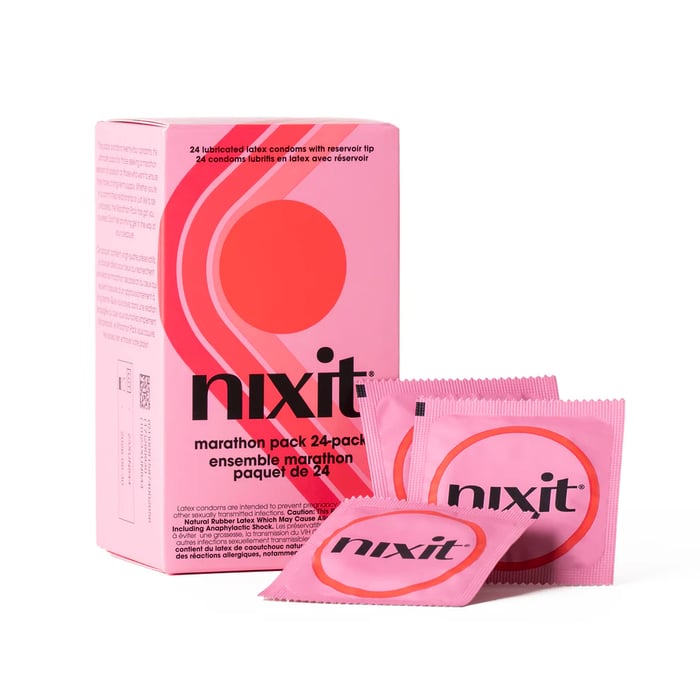You’re getting ready for a night out, or maybe just cleaning house, and you find a stray foil packet. It’s been living in your wallet since last summer’s music festival or hiding in the depths of a backpack.
The question hits: Do condoms expire? The simple, direct answer is yes: condoms absolutely expire.
Using an expired condom past its prime isn’t just a gamble; it significantly increases the risk of breakage and slippage. According to the NHS, condoms are 98% effective at preventing pregnancy when used correctly, but an expired condom is a compromised and damaged condom, especially if subjected to improper storage or extreme temperatures.
In this guide, we'll walk you through everything you need to know about condom longevity, including how to store condoms and check each condom's expiration date. This guide answers the critical questions, 'Do condoms expire?' and ‘Can improper storage affect them?’, and explains how to identify an expired condom before use.
Condom Shelf-Life by Material
Not all condoms are created equal, and their material composition directly influences how long they remain safe to use. From the common latex to non-latex options for those with allergies, here's a breakdown of what you can expect from an unopened condom with proper storage.
Condom Material | Typical Shelf Life (Unopened) | Need-to-Know Notes |
|---|---|---|
Latex condoms | Up to 5 years | Latex condoms are the most common and are heat-sensitive. |
Polyurethane condoms | Up to 5 years | Polyurethane condoms are good for latex allergies. |
Polyisoprene condoms | Up to 3 years | Polyisoprene condoms (artificial rubber) are stretchier than polyurethane. |
Lambskin/Natural Membrane condoms | Up to 1 year | Lambskin condoms do not block STIs. |
An important rule to remember is that the clock starts ticking from the manufacturing date, not the day you buy the condoms. Always check the expiration date printed on the condom wrapper at the point of purchase to ensure you're getting a fresh supply with plenty of life left.
nixit condoms
Other Factors That Speed Up Condom Expiration
Even an unexpired condom well within its printed expiration date can fail if certain conditions accelerate material breakdown. Understanding what causes condoms to degrade and avoiding those conditions is essential for safe use.
Heat
Extreme temperatures above 30°C accelerate chemical breakdown. Car interiors can hit and exceed 50 °C (122 °F), making glove boxes one of the worst places to store condoms. Body heat in wallets can also gradually damage condoms over time.
Direct Sunlight & UV Exposure
UV rays break down latex proteins and synthetic polymers, weakening the material and reducing elasticity. This is why, aside from checking the condom's expiration date, you should never store condoms near windows or in direct sunlight and make sure they haven't been compromised by UV exposure.
Humidity & Moisture
Steam and dampness weaken materials and packaging seals. Bathrooms might seem like a convenient place to store condoms, but the fluctuating humidity from showers can compromise condom integrity.
Friction & Pressure
Constant rubbing in wallets or pockets wears down both the foil wrapper and the condom itself. Even minor tears in the packaging can expose the condom to air and contaminants.
Improper Storage
Where you keep your condoms matters. Proper condom storage means keeping them in a cool, dry place like a bedside drawer.
Don't keep condoms loose in your wallet for weeks because constant pressure and friction wear down the wrapper and the condom itself. For portability, use a slim metal or silicone travel tin designed for condom storage.

5 Quick-Check Red Flags
Before using a condom, perform a quick inspection to catch potential problems. If you notice any of the following warning signs, throw it out immediately and get a new condom.
Check the condom’s expiration date. Look for an embossed or printed expiry date along one of the crimped, sealed edges of the condom wrapper, formatted as "EXP 2027-11." You may also see a manufacturing code like "LOT 2103," but always focus on the EXP date. If the expiration date has passed, the expired condom should be discarded immediately.
Look for physical signs of damage:
- The material feels sticky, brittle, or has a powdery texture.
- The condom is noticeably yellow, brown, or discolored.
- The lubricant appears dry, clumpy, or has a flaky film.
- It has an unusual, strong odor, such as a rancid chemical or overly rubbery smell.
- The condom wrapper was torn, inflated, or had a watery residue inside upon opening.
Before opening the packet, do a quick physical test: Gently squeeze the foil wrapper. You should feel a small cushion of air, indicating the seal is intact. If it feels completely flat or overly puffed up, the seal has been compromised, and air or moisture may have gotten inside. Even if the expiration date looks fine, a broken seal means the condom is no longer reliable.
This 30-second inspection can be the difference between effective protection and contraceptive failure. When in doubt, throw it out. It's always better to grab a fresh, unexpired condom than risk using one that's been compromised.
Risks of Using an Expired Condom
Using an expired condom fundamentally defeats its purpose, whether it's latex condoms or non-latex varieties, making it less effective. The primary risk is a significantly higher chance of failure. As the material degrades, it loses its strength and elasticity, making it far more prone to breaking during sex. This breakage instantly exposes you and your partner to the risks the condom was meant to prevent.
A compromised condom is a compromised barrier against sexually transmitted infections (STIs). The CDC states that condoms are highly effective in preventing HIV and other sexually transmitted infections (STIs) when used consistently and correctly.
An expired condom cannot provide this level of safety. Aside from the risk of infections, the risk of unplanned pregnancy also skyrockets, which can lead to immense emotional stress and anxiety.
nixit play safe bundle | condom pack + water-based lubricant
The Bottom Line
The integrity of your protection is fundamental to your sexual health. All condoms, from latex to polyurethane condoms, have an expiration date for a reason: because the materials they're made from degrade over time. Remember that shelf life varies by material and that proper condom storage is just as critical as the expiration date on the wrapper.
By making a habit of checking the expiration date, inspecting the wrapper, and maintaining proper condom storage in a cool, dry place, you empower yourself to have safer, more confident sexual experiences. Prioritizing body-safe products is key to overall wellness.
At nixit, we're all about body-safe sexual wellness products and the straight facts you need to use them confidently. Because of your safety and peace of mind? Non-negotiable.
Be sure to check our vegan-friendly, ultra-thin latex condoms before you go!
Frequently Asked Questions
How long do unopened condoms last in hot climates?
In consistently hot climates, the shelf life can be significantly reduced. Store them indoors in the coolest available spot and try to use them within a year or two of purchase to be safe.
Do flavored or spermicidal condoms expire faster?
Yes, they often do. Spermicide can reduce a condom's shelf life by up to two years, and the additives used for flavor or color can also slightly accelerate material breakdown.
Can stores legally sell expired condoms?
No, it is illegal to sell expired over-the-counter medical devices, which include condoms. If you find expired products on a shelf, you should notify the store manager.
Do personal lubricants expire, too?
Yes, lubricants also have an expiration date. Using an expired lubricant can lead to irritation, infections, or reduced effectiveness, so always check the bottle.
What if the package is intact, but there’s no expiration date?
If there is no visible expiry date on the individual wrapper or the outer box it came from, you cannot verify its age or safety. Do not use it; it's safest to throw it away.







